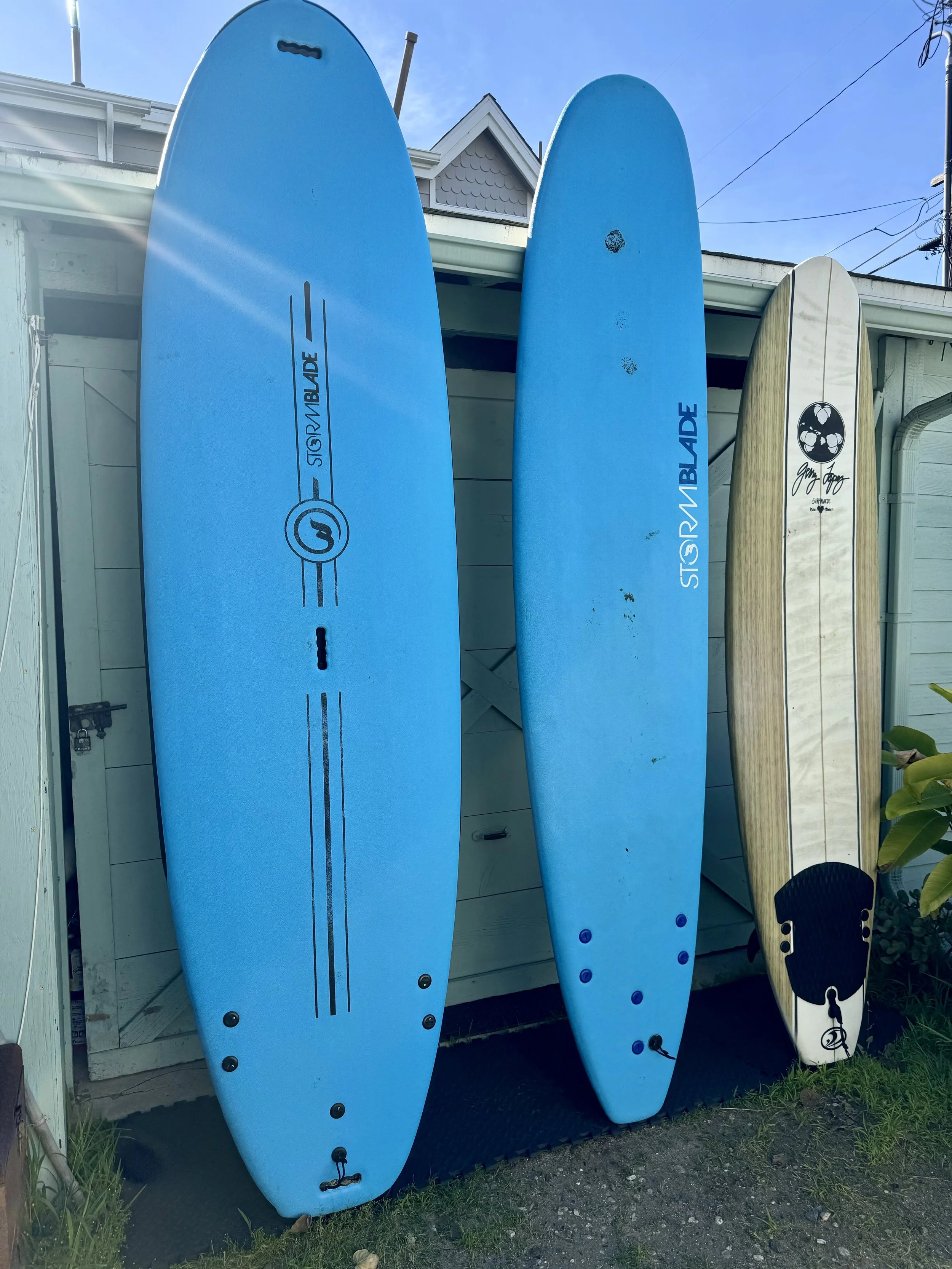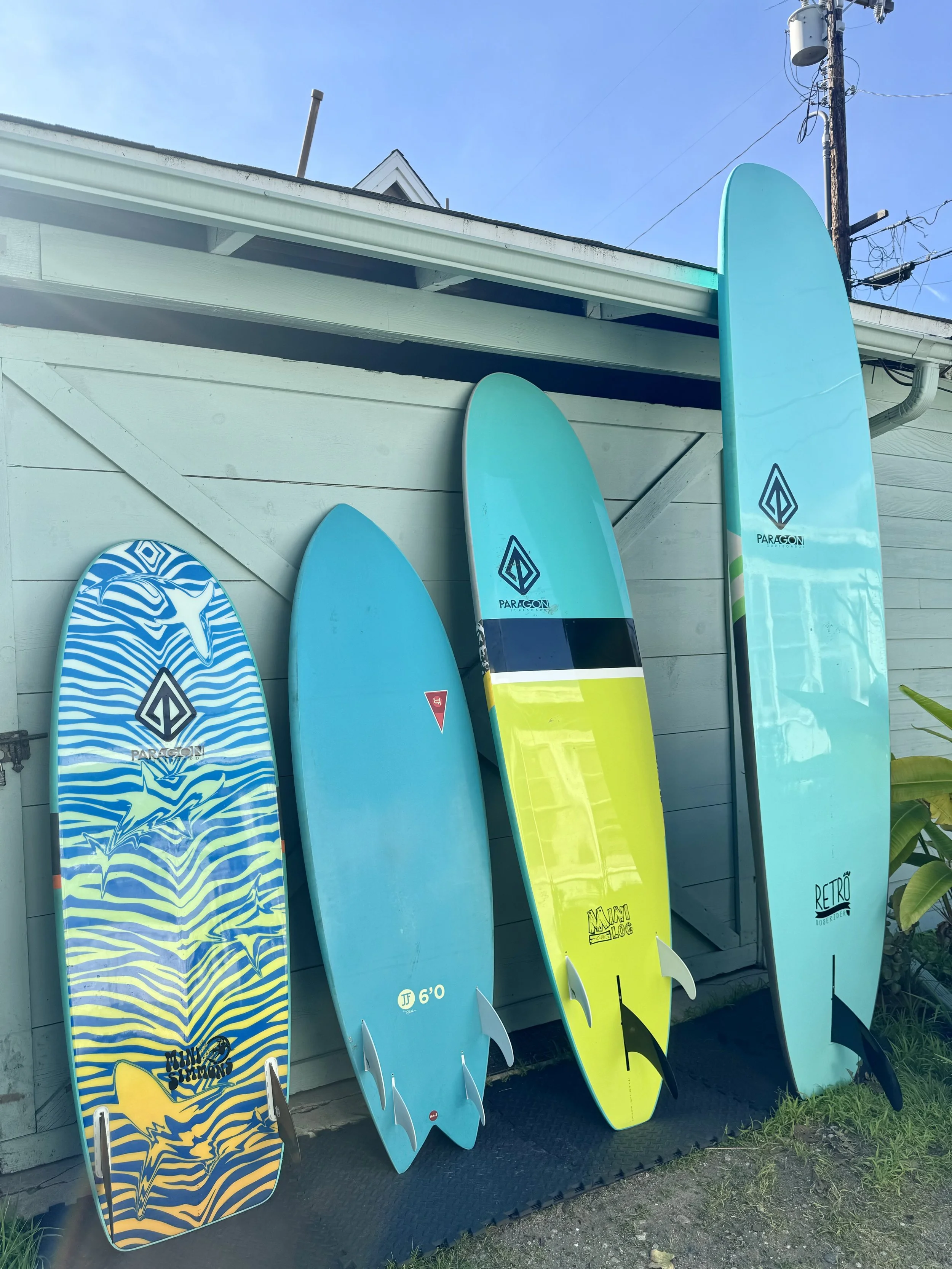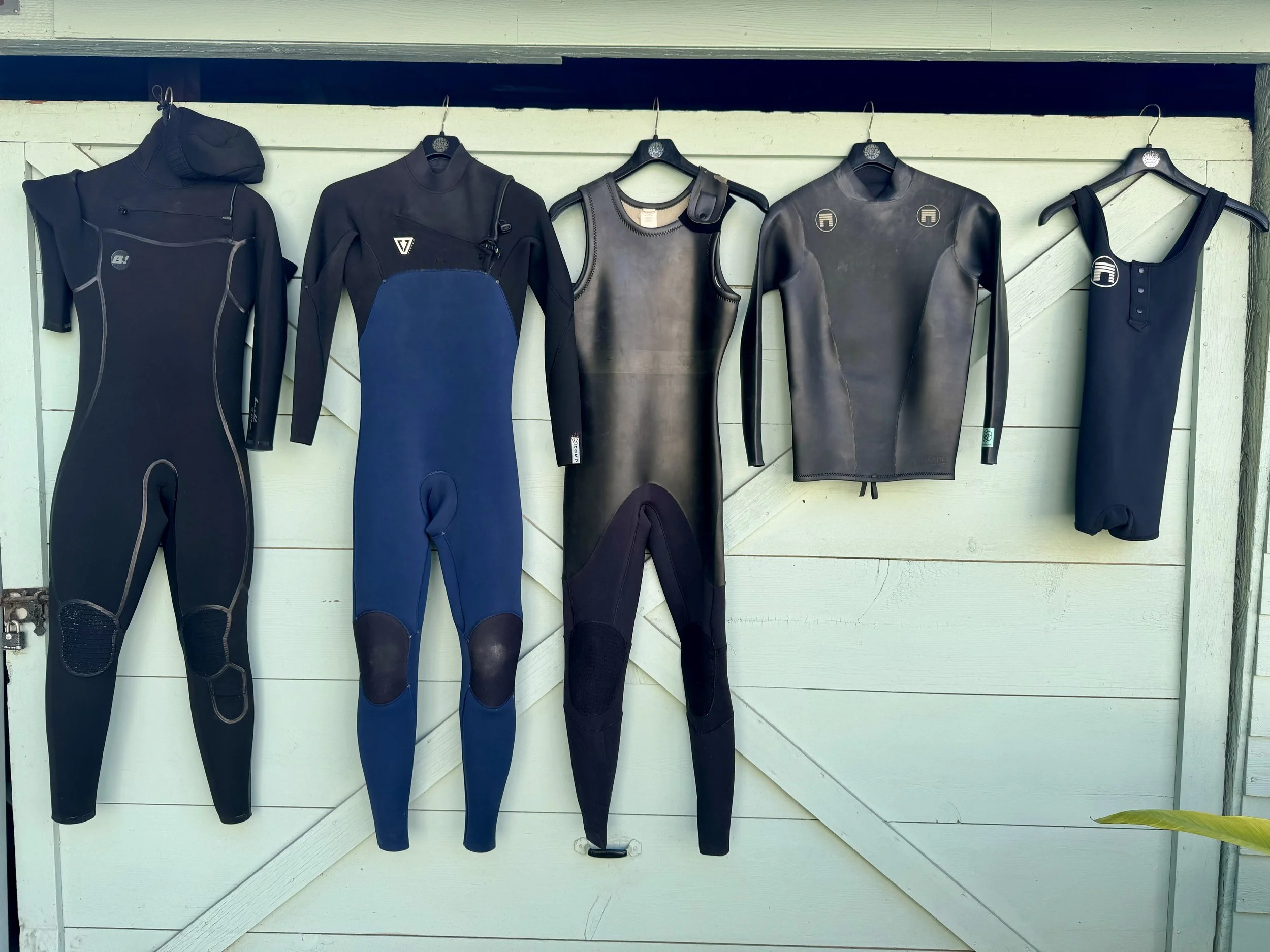Learn to Surf - Learn about Surfing Equipment
Foam surfboards are best for learning! Safe, stable, and easier to paddle! From left to right: Stormblade 9ft SSR Max foam surfboard (5 inches wider than the average 9ft foam board, great for people 160 pounds and above that are just getting started or for smaller people that need a little extra stability), Stormblade 9ft foam surfboard (great for people 120-150 pounds that are just getting started or smaller people that need a little extra stability, this board is more maneuverable than the SSR Max), Gerry Lopez 8ft foam surfboard (great for people 120 pounds or less that are just getting started).
High performance foam surfboards are great for people that are riding down the line thinking about doing maneuvers and want something that will perform well but be safer than regular hard boards! From left to right: Paragon 5’6” Mini Simmons foam surfboard, Pyzel 6’0” Astro fish foam surfboard, Paragon 7’6” Mini log foam surfboard, Paragon 9’0” Retro Noserider foam surfboard.
From left to right: Paragon 5’6 Mini Simmons foam surfboard (twin fin-two large fin boxes, looser of more skatey feel), Pyzel 6’0” Astro fish foam surfboard (quad fin-four fin boxes/two large and two small, can be ridden as a twin for a looser feel or guard for more grab on the wave face), Paragon 7’6” foam surfboard (1+2-one large fin box and two smaller fin boxes, can be ridden as a single fin or with three fins for more grab on the wave face), Paragon 9’0” Retro Nose rider (single fin, more traditional feel).
From left to right: Buell 4/3mm hooded wetsuit (super flexible and warm, great for winter and spring), Vissla 3/2mm Competition wetsuit (extra flexible for more range of motion when paddling, great for summer and fall), Vintage Roxy Long leg sleeveless wetsuit (great for summer), Matuse 2mm Chapter 1 wetsuit Jacket (fits like a second skin, great for summer. I use a towel to pull it into place so my nails don’t cut the material), Matuse Reversible 1.5mm spring suit wetsuit, great for the tropics or extra warm summers).
Dress up any wetsuit to add more warmth! Rip Curl Flashbomb 3mm surf booties (my fave booties of all time, super warm and not bulky), O’neill Psycho Tech surf gloves (warm and not bulky), Patagonia R2 Wetsuit hood (warm and not claustrophobic).
Learning about surfing equipment can make a massive difference is important so that you can progress and have more fun! Here is some equipment vocabulary to help you out.
Surfboards: Being on the right surfboard for your skill ability or desired progression can make all the difference. Not having fun, try a different board!
Hard Surfoards (best for intermediate and advanced surfers) - Surfboards made of PU, epoxy, a blend of PU and epoxy, or other materials that are hard or stiff. These boards are typically more performance oriented and hurt more if you get hit with them, definitely better when you have more experience and can enjoy something more manueverable. When you have more experience you rarely get hit by the board. Not ok to ride these onto the sand as you can break the fins or fin boxes upon impact into the ground.
Foam Surfboards (best for beginner surfers) - Surfboards made of compacted soft foam (like a giant boogie board), these boards have softer and more flexible fins that will bend instead of cut you and are ok to ride onto the sand as the fins won’t break.
High Performance Foam Surfboards (best for intermediate and advanced surfers) - Surfboards that are high performance but made of hard foam, safer than hard surfboards. Not ok to ride these onto the beach as they have legit fin boxes that could break upon impact of the fins into the ground.
Shortboard Surfboards - High performance surfboards great for progression and manuevers. You can add more volume to a shortboard to give it more stability and paddle ability.
Mid Length Surfboards - Typically in the 6’6” to 8’0” range, great for extra paddle and stability. Good for less experienced surfers, small waves, or bigger waves. Can be high performance depending on shape and fin setup.
Longboard Surfboards - Typically in the 8’0” plus range, great for extra paddle and stability. Great for less experienced surfers, small waves, or bigger waves. Can be used for nose riding. Can be high performance depending on shape and fin setup.
Surfboard Tail Shapes: The shape of a surfboard tail can make a big difference in how the board rides/feels, some tail shapes can be more stable for surfers with less experience. Ultimately, its a personal preference and can change over time or in different conditions.
Squash Tail - Square tail, high performance and stable.
Pin/Rounded Pin Tail - Offers drive and flow on steeper waves and through big turns.
Swallow Tail - Allows water to move more freely off the tail making it easier to generate speed especially through flat sections. Also spicier for turns allowing the tail to slide more freely.
Fish Tail - Basically an exaggerated swallow tail that offers even more ability to generate speed and slide the tail out through turns! Feels like skateboarding but even looser, can feel too loose or skatey for surfers with less experience.
Surfboard Fins: The development of fin systems has made it easier to travel with boards and give your board a different feel when riding. Changing the fins on your board can make if feel like a completely different board, if you don't like how your board rides try changing the fins!
FCS/FCS2 (aka twin tab) Fins - FCS is the first company to create fin systems. They’re original fin systems (some board brands still make boards with the original FCS boxes) require two fin screws to hold them in place. FCS2 systems use fins that pop into place eliminating the need for fin screws and keys, these fins are meant to pop out if you hit the bottom eliminating the destruction of fin boxes. There is a FCS fin tool available if you find it difficult to pop the fins in and out (like I do).
Futures Fins (aka single tab) - Futures have one continuous tab and require a single screw to hold them in place. I have had to sand fins to get them to fit into fin boxes, not a big deal.
*I’m a huge fan of having options, if you want options get more fin boxes!
Surfboard Fin Sizes: The amount of fins and size of fins dictate the amount of hold on a wave face, if you want more hold (stability) use more or bigger fins and if you want less hold (looser) use less or smaller fins.
Single Fin - The original fin configuration, great for stablility and straighter down the line surfing. More challenging to do tight turns, can move the fin forward for a looser feel and back for stability.
Twin Fin - Super maneuverable and skatey, great for long drawn out turns and generating speed through flat sections.
Thruster (3 fins) - This fin system revolutionized high performance surfing, offering lots of control for high speed tight turns. Probably the most common fin configuration.
Quad (4 fins) - Quads offer acceleration in smaller waves and hold in bigger waves, help generate drive through turns.
2 + 1 Fin Setup - This fin setup consists of two larger fins and a smaller fin (trailer) in the center. Basically the skatey feeling of a twin fin but with enough fin in the middle to reengage after a big turn or hold on a steeper wave face. Currently my favorite fin setup!
1 + 2 Fin Setup - Consisting of one larger fin and two smaller fins a (side bites), this fin configuration can offer more grab on steeper wave faces and hold through bottom turns or tight turns. A nice option to have on your midlength or longboard.
Surf Leashes: Wearing a leash while surfing will save you energy as you don’t have to swim for your board eand be safer for everyone else in the water. Having a the appropriate length leash is important to minimize risk of getting hit by your board, your leash should be as long or longer than your surfboard (example: 8ft board, 8ft + length leash), this way if your leash hits max extension and sling shots your board back at you it has time to slow down and ideally stop before it hits you.
Competition Surf Leash (aka Comp leash) - Comp leashes are noticeably lighter and my favorite for shortboards.
Knee Surf Leash - On knee leashes the velcro portion of the leash is longer so that it can be worn below your knee joint instead of on your ankle, this is my preferred leash for longboards as it seems to get less tangled.
Wetsuits: Wetsuits come in a variety of thickness and configurations depending on water temperatures and personal preferences. You can dress a wetsuit up (make warmer) by accessorizing with surf booties, surf gloves, a surf hood, or a fleece rash guard.
*All wetsuit brands have a sizing chart, consult to make sure you are getting the right size. Some brands offer Short and Tall sizes which can offer a better fit.
Front Zip Wetsuits - Pull over your head and zip in the front for convenience, sometimes has a snugger fit on the neck to let less water in.
Back Zip Wetsuits - Zip in the back, have a long string attached so that you can zip it up yourself. Open up more making it easier to get into, can be a good option for thicker wetsuits in colder climates.
Fullsuit Wetsuit - Long arms and long legs, this is a great standard wetsuit to have if you live somewhere that gets colder, they come in a variety of thickness (2/1mm, 3/2mm, 4/3mm, 5/4mm, 6/5mm) recommendations based on water temperature. If you run cold you can go up a millimeter for extra warmth. Fullsuits are typically a millimeter less in the arms for added range of motion.
Springsuit Wetsuit - Short arms and short legs, great for warmer times of the year or longer sessions in warmer climates.
*There are other configurations of wetsuits such as the following self explanatory examples: Long sleeve spring, Sleeveless full (aka farmer John).
Surf Booties - Using surf booties can add significant warmth and extra grip on your board.
Short Surf Booties - Typically used for warmer water locations where there is concern of cutting your feet on sharp reef/rocks.
Tall Surf Booties - Great for colder water climates as they offer additional warmth without letting additional water in.
Surf Hood - There are a variety of styles and thicknesses of surf hoods available, they do add significant warmth and prevent ice cream headaches in colder water climates. Can be a great option if you dislike booties but want additional warmth. Many hoods come with little visors that are handy for keeping the sun out of your eyes!
Surf Gloves - Surf gloves can be great for surfing colder water climates or if your hands get cold easily. They come in a variety of thickness suggestions depending on water temperature. The thicker the gloves the heavier they feel when paddling.
Fleece Rash Guards - Fleece rash guards are worn underneath your wetsuit and can add a millimeter of warmth, great for dressing up a lighter wetsuit.
Thanks for reading, feel free to reach out or take a lesson with Us if you need any guidance or support on anything surf!
Aloha,
Heather





